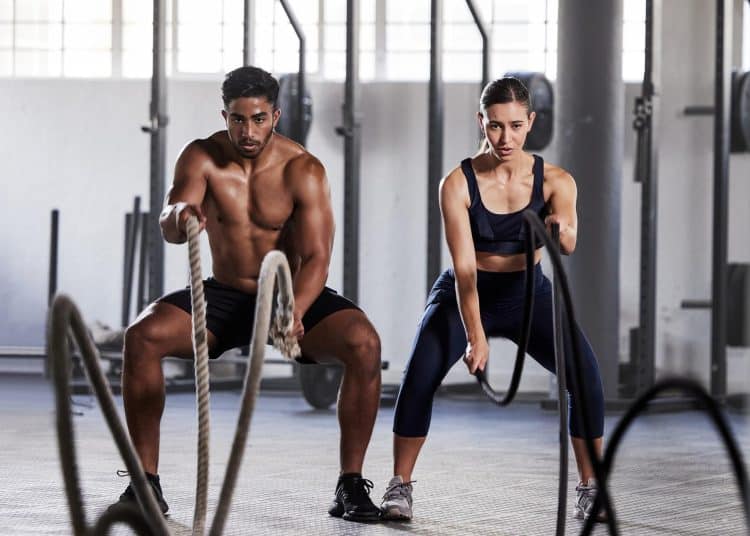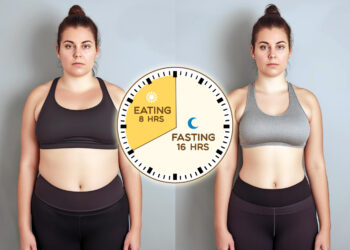Intermittent fasting (IF), once seen as an extreme form of dieting, has well and truly entered the mainstream. The experience of millions of people, backed up by solid science, has proven IFs’ ability to help lose body fat safely. Yet, one confusion persists — How should you exercise while fasting?
Is training at your typical intensity safe when you’re running low on energy? Or should you only work out during your feeding windows? And what type of exercise (cardio or resistance training) is ideal during a fast?
As a veteran personal trainer, I have been experimenting, personally using, and advocating the intermittent fasting lifestyle for more than a decade. One of the most important issues I explain to my clients is how fasting affects their ability to exercise and how they should adjust their workouts.
If you’ve been in the dark about how to train for optimal fat loss results while intermittent fasting, then you’re in the right place. In this article, I’ll provide you with the very workouts that I’ve been prescribing to my clients to maximize their gains while fasting.
Fasted Cardio Workout
During fasting, your muscles exhaust their glycogen stores, their primary energy source. This forces your body to switch to burning stored body fat for its energy demands. As a result, fasted workouts burn more body fat than exercising after a meal.
Level Up Your Fitness: Join our 💪 strong community in Fitness Volt Newsletter. Get daily inspiration, expert-backed workouts, nutrition tips, the latest in strength sports, and the support you need to reach your goals. Subscribe for free!
This was confirmed in a 2016 study involving participants who did a 60-minute run in both a fasted and a non-fasted state. The fat oxidation was significantly higher when the exercise sessions were performed in a fasted state. [1]
However, you will also have less energy for your workout when you are in a fasted state. Here are three highly effective steady-state cardio workouts that will put you in the fat-burning zone without pushing your body beyond its limit:
Workout One: 25-7-2 Stairmaster
Get on a stairmill, set it to an intensity level of seven, and use it for 25 minutes.
This simple stepping workout has gone viral due to its simplicity and ability to produce results, both in burning calories and cardio endurance, without pushing you out of the fat-burning zone.
Workout Two: Rowing
Rowing is one of my favorite forms of cardio due to its ability to engage nearly every muscle in your body. It is also one of the few cardio exercises that engages your back, shoulders, and arms along with the lower body.
Get on the rowing machine and establish a moderate pace that you can continue for 30 minutes. I suggest setting a target to stay between 20-25 strokes per minute. This will keep you in the fat-burning zone.
The 16/8 method is one of the most popular forms of intermittent fasting. Find out if it’s the right fit for you.
Workout Three: 12-3-30 Treadmill
The 12-3-30 method is another cardio fat-burning workout that has gone viral due to its simplicity and effectiveness. This one is considerably more challenging than the 25-7-2 stairmill workout, as you work at a steep incline.
Set the treadmill to a 12 percent incline, set the speed to 3 miles per hour, and walk for 30 minutes.
I recommend doing three fasted cardio workouts per week on alternate days. I have my personal training clients alternate between the three workouts described above for variety. This ensures that every muscle group in the body is being stimulated.
HIIT Feeding Window Workout
Your fasted, steady-state cardio workouts will provide you with a safe, steady calorie expenditure focused on burning fat for energy. But you can and should do more to optimize your intermittent fasting fat loss through exercise.
High-intensity interval training (HIIT) involves short bursts of full-send cardio followed by a quick recovery window. This pattern is repeated for multiple rounds. HIIT training is very demanding. As a result, it will burn a considerable amount of calories.
HIIT also stimulates what is known as the EPOC effect. EPOC stands for excess post-excess oxygen consumption, also known as the afterburn effect. Since restoring your body to its resting metabolic rate takes considerable time, you’ll continue to burn additional calories for several hours post-workout.
Your HIIT training sessions should only be performed during your eating window after consuming complex carbohydrates and protein. This will provide the extra energy needed to carry out these workouts. I recommend waiting at least 90 minutes after eating before exercising.
Level Up Your Fitness: Join our 💪 strong community in Fitness Volt Newsletter. Get daily inspiration, expert-backed workouts, nutrition tips, the latest in strength sports, and the support you need to reach your goals. Subscribe for free!
There are several HIIT training variations. The one I prefer to use with my IF clients for fat loss is the original form developed by a Japanese professor named Izumi Tabata, which has come to be known as the Tabata Protocol.
Here is how to perform a HIIT Tabata workout.
- Select your training equipment. I prefer an exercise bike, but you can use any form of cardio to perform at maximum intensity, including a treadmill, rowing machine, or jump rope.
- Start with a slow speed during a two-minute warm-up. Gradually increase the pace so that you are at maximum intensity at the two-minute mark (you should be at around 170% of VO2 max). Imagine you are being chased by a big (and very hungry) dog!
- At the 2:20 mark, stop pedaling or sprinting to recover for exactly 10 seconds. If you are on a treadmill, step onto the side rails instead of adjusting the belt speed.
- At 2:30, perform your next all-out twenty-second sprint.
- Continue this pattern for eight rounds. Ensure that there is a minimal drop-off in intensity with each succeeding round.
- Finish with a two-minute cooldown.
Fasted Resistance Workout
Resistance training should be a part of all fat loss exercise programs. It is particularly important when you’re fasting. In the fasted state, you risk losing muscle tissue. Without protein and carbs, your body may break down muscle tissue for energy.
Resistance training can counter the potential muscle loss. But it will only do so if it is timed properly within your fasting cycle.
I recommend that my clients train each body part twice weekly while on an intermittent fasting program. The first workout involves moderate intensity with relatively high repetitions, ideally performed towards the end of your fasting period to ensure protein intake within an hour.
The second resistance workout should involve going heavy with 6-8 reps per set. This workout should only be done during your eating window, at least an hour after getting carbs and protein into your system.
Here is a two-way split fasted resistance training workout program:
Day One: Chest, Back, Trapezius, Biceps, Triceps
- Dumbbell Bench Press: 4 x 30/20/15/12 reps
- Decline Flyes: 3 x 15 reps
- Lat Pulldown: 3 x 30/20/15 reps
- Bent-Over Barbell Rows: 3 x 15/12/12 reps
- Dumbbell Shrugs: 3 x 20/15/12 reps
- Alternate Cable Curls: 4 x 30/20/15/12 reps
- Triceps Pushdowns: 4 x 30/20/15/12 reps
Day Two: Quadriceps, Glutes, Hamstrings, Calves, Shoulders
- Squats: 3 x 30/20/15 reps
- Leg Extensions: 3 x 30/20/15 reps
- Glute Kickbacks: 3 x 30/20/15 reps
- Seated Leg Curls: 3 x 30/20/15 reps
- Leg Press Calf Raises: 3 x 30/20/15 reps
- Seated Dumbbell Shoulder Press: 3 x 30/20/15 reps
- Side Lateral Raises: 3 x 30/20/15 reps
Heavy Resistance Feeding Window Workout
Two days per week, engage in heavy workouts. These should be done during your feeding window. Break your fast with a meal that includes complex carbohydrates and protein. My favorite is oatmeal sprinkled with blueberries, walnuts, and protein powder.
Here’s a sample two-day split heavy weight workout to perform during your feeding window:
Day One: Chest, Back, Trapezius, Biceps, Triceps
- Dumbbell Bench Press: 4 x 12/10/8/6 reps
- Cable Machine Press: 3 x 10/8/6 reps
- Deadlift: 4 x 12/10/8/6 reps
- T-Bar Rows: 3 x 10/8/6 reps
- Machine Shrugs: 3 x 12 reps
- Alternate Dumbbell Curls: 4 x 12/10/8/6 reps
- Skull Crushers: 4 x 12/10/8/6 reps
- Close-Grip Pull-Ups: 3 x failure
Day Two: Quadriceps, Glutes, Hamstrings, Calves, Shoulders
- Squats: 4 x 12/10/8/6 reps
- Lunges: 3 x 12 reps
- Glute Kickbacks: 4 x 12/10/8/6 reps
- Seated Leg Curls: 3 x 10/8/6 reps
- Leg Press Calf Raises: 3 x 30/20/15 reps
- Seated Dumbbell Shoulder Press: 4 x 12/10/8/6 reps
- Rear Delt Raises: 3 x 12 reps
How Fasting Affects Your Exercise Potential
Food fuels your body. So, when you deprive your body of food, your energy levels will be affected. Your body relies on two food sources for energy:
- Carbohydrates
- Fat
Once digested, carbohydrates are converted into glycogen in your body. This is the body’s primary and preferred energy source. It is stored in your muscles to be used when needed. However, the body can only store a relatively small amount of glycogen within the muscles.
When you’re in a fasted state, your body will deplete its glycogen stores within 16-18 hours. It will then have no choice but to draw upon its secondary fuel source, stored body fat. As a result, you will not have the rocket fuel type of energy that you would have with glycogen.
The main consequence of all of this is that you won’t be able to bring the same level of energy and endurance to your training while you are in a fasted state. That’s why you need to adjust the intensity of your workouts in accordance with your feeding times.
Importance of Workout Timing
Workout timing is the most crucial consideration when intermittent fasting. Sticking to your usual workout routine while fasting without adjusting for varying energy levels can lead to burnout. You’ll also see your strength levels plummet.
The key message here is that working out while fasting is fine. However, you must adjust the training intensity to account for your reduced energy level. Here are the four IF training rules you should follow:
- Low-intensity steady-state (LISS) cardio during your fasting window.
- Do a high-rep, moderate-weight resistance workout toward the end of your fasting window so you can eat a high-protein meal within an hour of completion.
- High-intensity interval training (HIIT) workouts only during your eating window after you have fuelled up.
- Perform heavy-weight resistance training about an hour after breaking your fast with a high-complex carb and protein meal.
Sample Workout Plan During an Intermittent Fasting:
| Mon | Tue | Wed | Thu | Fri | Sat | Sun |
| Fasted (1st session) |
Fasted (1st session) |
Rest Day | Fasted (1st session) |
Fasted (1st session) |
Rest Day | Rest Day |
| Resistance Training (Medium) |
Resistance Training (Medium) |
LISS | Resistance Training (Heavy) |
|||
| Non-Fasted (2nd session) | Non-Fasted (2nd session) | Non-Fasted (2nd session) | Fasted (2nd session) |
|||
| HIIT | LISS | Resistance Training
(Heavy) |
HIIT |
5 Intermittent Fasting Workout Tips
Adopt the following advice for better results:
- Listen to your body: If exercising on an empty stomach leaves you feeling sluggish and off, consider shifting all your workouts to coincide with your feeding window. The fat loss benefits of fasted cardio will be negated if you can’t perform.
- Give your body time to digest: You should wait at least an hour after your fast-breaking meal. This will allow time for your body to digest the food, ensuring you don’t feel bloated during your workout. Make sure, too, that you eat your meal slowly and don’t overeat. Consuming a large amount of food immediately after fasting can lead to digestive discomfort.
- Stay hydrated: Increase your water intake during a fast. This will ensure you stay hydrated, especially during your exercise sessions. Drinking water also helps stave off hunger pangs, making you more likely to succeed in your fast. I recommend drinking at least two liters (half a gallon) of water during your fast. Sip from your water bottle throughout your workout.
- Get carbs and protein into your body soon after your workout: Even if you are training during your fasted window, make it close to the end so you don’t go too long without eating post-exercise.
- Replenish electrolytes: You’ll likely lose electrolytes such as potassium, magnesium, and sodium through sweat during your workout. Adding an electrolyte powder to your water will help replenish these essential compounds.
Wrap Up
Working out effectively while intermittent fasting comes down to two things:
- Timing
- Adjusting Intensity
Perform your low to medium intensity cardio and resistance workouts during your fasted period, close to when you are about to break the fast. Then, after you’ve fuelled up on complex carbs and protein, do your HIIT cardio and heavy-weight workouts.
The intermittent fasting workout program covered in this article has been and is being used by many people to optimize their fat loss results. Why not give it a try and discover how it aligns perfectly with your fasting energy levels to help you shed those unwanted pounds?
References:
- Bachman JL, Deitrick RW, Hillman AR. Exercising in the Fasted State Reduced 24-Hour Energy Intake in Active Male Adults. J Nutr Metab. 2016;2016:1984198. doi: 10.1155/2016/1984198. Epub 2016 Sep 21. PMID: 27738523; PMCID: PMC5050386.













